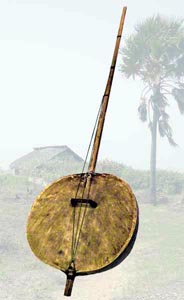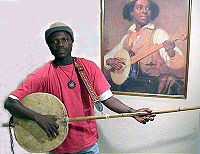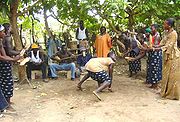
Akonting
Encyclopedia

Lute
Lute can refer generally to any plucked string instrument with a neck and a deep round back, or more specifically to an instrument from the family of European lutes....
of the Jola people, found in Senegal
Senegal
Senegal , officially the Republic of Senegal , is a country in western Africa. It owes its name to the Sénégal River that borders it to the east and north...
, Gambia, and Guinea-Bissau
Guinea-Bissau
The Republic of Guinea-Bissau is a country in West Africa. It is bordered by Senegal to the north, and Guinea to the south and east, with the Atlantic Ocean to its west....
in West Africa
West Africa
West Africa or Western Africa is the westernmost region of the African continent. Geopolitically, the UN definition of Western Africa includes the following 16 countries and an area of approximately 5 million square km:-Flags of West Africa:...
. It is a banjo
Banjo
In the 1830s Sweeney became the first white man to play the banjo on stage. His version of the instrument replaced the gourd with a drum-like sound box and included four full-length strings alongside a short fifth-string. There is no proof, however, that Sweeney invented either innovation. This new...
-like instrument with a skin-headed gourd
Gourd
A gourd is a plant of the family Cucurbitaceae. Gourd is occasionally used to describe crops like cucumbers, squash, luffas, and melons. The term 'gourd' however, can more specifically, refer to the plants of the two Cucurbitaceae genera Lagenaria and Cucurbita or also to their hollow dried out shell...
body, two long melody strings, and one short drone string, akin to the short fifth "thumb string" on the 5-string banjo.
Jola oral tradition places the birthplace of the akonting in the village of Kanjanka in Lower Casamance
Casamance
Casamance is the area of Senegal south of The Gambia including the Casamance River. It consists of Basse Casamance and Haute Casamance...
(Senegal), near the banks of the Casamance River
Casamance River
The Casamance River flows westward for the most part into the Atlantic Ocean along a path about 200 miles in length. However, only 80 miles of it are navigable. The Casamance is the principal river of the Kolda, Sédhiou, and Ziguinchor Regions in the southern portion of Senegal between The...
. The name of the instrument's home village is recalled in the most common tuning pattern for the akonting's three open strings (from the 3rd short "thumb" string to the 1st long melody string): kan (the 5th note of the scale, tuned an octave higher), jan (root note), ka (flatted 7th note). Like in the traditional old-time/folk styles of playing the 5-string banjo, the akonting is tuned in different tunings. Using the kanjanka tuning pattern of 5/1/-7, a common tuning in Casamance is dGF. In Gambia, for another variant the 1st long melody is raised a semitone (half-step) higher to make a natural 7th note, as in cFE.
Gambian Jola scholar/musician Daniel Laemouahuma Jatta
Daniel Laemouahuma Jatta
Daniel Laemouahuma Jatta is a Jola scholar and musician from Mandinary, Gambia, who pioneered the research and documentation of the akonting, a Jola folk lute, as well as the related Manjago folk lute, the buchundu, in the mid-1980s...
, who pioneered the research and documentation of the akonting in the mid-1980s, describes the music of his people's folk lute as follows:
- The music of the akonting is short sustained notes that are played over and over again. Usually they are between two to three notes. The mechanics involved in playing the akonting is the regular sounding of the short string (drone string) when playing any melody. It acts as a drum to add beauty to the melody. The middle string is also sometimes used as drone string. All the noting is done on the long string.
- The music of the akonting has been and still is folk music. Akonting players do not play music to confer status to their patrons. They play their music, usually in the evenings after work to relax and have a nice time before going to bed. Also when in their rice field bars (Hu Waa in Jola) they play the Akonting in the evening after working in their rice fields and drink their palm wine that they are expert in tapping from the palm tree. The music of the Akonting deals with all matters of life and does not need to be augmented by any other instrument to be danceable. It is rhythmic enough to enable one to dance.

Recent findings presented by researchers Daniel Laemouahuma Jatta, Ulf Jägfors, and Shlomo Pestcoe at The 8th Annual Banjo Collectors Gathering (December, 2005)-- an annual international conference of the foremost collectors and scholars of 19th and early 20th century banjos, which also serves as the principal forum for presentations of new research on the banjo's history and organology
Organology
Organology is the science of musical instruments and their classification. It embraces study of instruments' history, instruments used in different cultures, technical aspects of how instruments produce sound, and musical instrument classification...
-- indicate that the banjo is probably descended from the many different types of gourd-bodied folk/artisan plucked lutes found throughout West Africa, like the akonting and its aforementioned Senegambian siblings. Other varieties include the Frafra koliko (Ghana), The Kotokoli (also Tem or Temba) lawa (Togo, Benin and Ghana), the Gwari kaburu (Nigeria), and the Hausa gurmi, komo, komsa and wase (Nigeria, Niger, Ghana), to name but a few. The earliest forms of the banjo were, in fact, very similar gourd-bodied lutes, which enslaved West Africans in the Caribbean began making and playing sometime in the early 17th century.
Missing link to the banjo?
Of all the myriad variety of West African plucked lutes, the Jola akonting stands out as the one instrument today that bears the strongest resemblance to early North American gourd banjoBanjo
In the 1830s Sweeney became the first white man to play the banjo on stage. His version of the instrument replaced the gourd with a drum-like sound box and included four full-length strings alongside a short fifth-string. There is no proof, however, that Sweeney invented either innovation. This new...
s. This is seen not just in its physiology but also in the traditional technique used to play the akonting, called o'teck (literally, "to stroke"), which is basically the same as the stroke, or frailing style, considered to be the oldest extant technique for playing the banjo.
Both the akonting o'teck and the banjo stroke style are forms of down-picking, a technique in which the fingernail of a single finger -- either the index or middle finger -- is used to strike the individual melody strings in a downward motion, like a plectrum
Plectrum
A plectrum is a small flat tool used to pluck or strum a stringed instrument. For hand-held instruments such as guitars and mandolins, the plectrum is often called a pick, and is a separate tool held in the player's hand...
. This action is immediately followed by the player's thumb catching on the top short "thumb string" to create a rhythmic back-beat accompaniment.
It was the stroke style of banjo that European American performers, who came to be known as blackface
Blackface
Blackface is a form of theatrical makeup used in minstrel shows, and later vaudeville, in which performers create a stereotyped caricature of a black person. The practice gained popularity during the 19th century and contributed to the proliferation of stereotypes such as the "happy-go-lucky darky...
minstrels (see minstrel show
Minstrel show
The minstrel show, or minstrelsy, was an American entertainment consisting of comic skits, variety acts, dancing, and music, performed by white people in blackface or, especially after the Civil War, black people in blackface....
), initially learned from African American musicians in the early 19th century.(The blackface minstrels popularized the banjo in the 1830s and 40s. Prior to that the banjo was a folk instrument exclusive to African American and African Caribbean musicians.) This was the prevalent form of playing the 5-string banjo until the advent of the guitar style of up-picking in the late 1860s, also referred to as finger-picking. The stroke style of down-picking has survived to this very day in the folk traditions of both the black and white communities of the rural South, where it's commonly referred to as frailing, clawhammer
Clawhammer
Clawhammer is a highly rhythmic banjo playing style and common component of American old-time music. The principal difference between clawhammer style and other styles is the picking direction...
, thumping, among other terms.
Remarkably, the Jola o'teck technique of playing the akonting is the only extant
down-picking style of lute playing found in all of West Africa thus far. Even more pertinent to the ongoing search for the banjo's ancestors, it's the only West African lute with a banjo-like short "thumb string" which is played in this manner.
In addition to the Jola akonting, the Manjago buchundu, the Papel busunde, the Balanta kisinta, and all the various kinds of wooden-bodied lutes that are exclusive to the griots (for example, the Mande ngoni, the Wolof
Wolof people
The Wolof are an ethnic group found in Senegal, The Gambia, and Mauritania.In Senegal, the Wolof form an ethnic plurality with about 43.3% of the population are Wolofs...
xalam, the Fula
Fula people
Fula people or Fulani or Fulbe are an ethnic group spread over many countries, predominantly in West Africa, but found also in Central Africa and Sudanese North Africa...
hoddu, and the Soninke gambare) have a short "thumb string" drone. The "thumb string" seems to be a feature unique to lutes of Senegambian origin which have three or more strings and are played with the fingers, regardless of playing style. Conversely, 1-string lutes (e.g. the gourd-bodied gambra of the Haratin
Haratin
Haratin are oasis-dwellers in the Sahara, especially in southern Morocco and Mauritania, who make up a socially and ethnically distinct group of largely sedentary dark colored workers speaking either Berber or Arabic...
of Mauritania
Mauritania
Mauritania is a country in the Maghreb and West Africa. It is bordered by the Atlantic Ocean in the west, by Western Sahara in the north, by Algeria in the northeast, by Mali in the east and southeast, and by Senegal in the southwest...
) and 2-string lutes (e.g. the gourd-bodied koliko of the Frafra
Frafra
Frafra is a colonialist term given to a subset of Gurunsi peoples living in northern Ghana and their language. The larger group of Gurunsi peoples inhabit both southern Burkina Faso and northern Ghana...
of Ghana
Ghana
Ghana , officially the Republic of Ghana, is a country located in West Africa. It is bordered by Côte d'Ivoire to the west, Burkina Faso to the north, Togo to the east, and the Gulf of Guinea to the south...
and the wooden-bodied garaya of the Hausa
Hausa people
The Hausa are one of the largest ethnic groups in West Africa. They are a Sahelian people chiefly located in northern Nigeria and southeastern Niger, but having significant numbers living in regions of Cameroon, Ghana, Cote d'Ivoire, Chad and Sudan...
of Nigeria
Nigeria
Nigeria , officially the Federal Republic of Nigeria, is a federal constitutional republic comprising 36 states and its Federal Capital Territory, Abuja. The country is located in West Africa and shares land borders with the Republic of Benin in the west, Chad and Cameroon in the east, and Niger in...
, Niger
Niger
Niger , officially named the Republic of Niger, is a landlocked country in Western Africa, named after the Niger River. It borders Nigeria and Benin to the south, Burkina Faso and Mali to the west, Algeria and Libya to the north and Chad to the east...
, and Ghana) are played with flat-pick type plectrums, so a drone string is useless on these instruments.
The standard griot playing technique is a 2-finger up-picking pattern: the player's index finger plucks up on a melody string, followed by the thumb plucking the short drone string, and culminating with the index finger brushing down all the strings. While the griot technique is strikingly similar to some styles of old-time 2-finger up-picking found in various regions of rural southern United States, it is distinctly different from down-picking and not related to the early "stroke style" of playing the 5-string banjo or its descendants, the various old-time Southern down-picking styles.

The Akonting today
In the mid-1980s, when Gambian Jola scholar/musician Daniel Laemouahuma Jatta first began to research and document his people's folk lute, the akonting, the tradition of making and playing the instrument was relatively unknown outside of the rural Jola villages found throughout Senegambia. Even within these Jola communities, there were very few young people interested in carrying on the akonting tradition. Recognizing this fact, Daniel's father, a traditional akonting player originally from the instrument's birthplace, the CasamanceCasamance
Casamance is the area of Senegal south of The Gambia including the Casamance River. It consists of Basse Casamance and Haute Casamance...
region of Senegal
Senegal
Senegal , officially the Republic of Senegal , is a country in western Africa. It owes its name to the Sénégal River that borders it to the east and north...
, implored him to take up the akonting and help perpetuate this vital element of their people's cultural heritage.
Today, there is a burgeoning revival of interest in the akonting within its home region of Senegambia. Young akonting players like Bouba Diedhiou, a teenage radio performer from a rural Casamance
Casamance
Casamance is the area of Senegal south of The Gambia including the Casamance River. It consists of Basse Casamance and Haute Casamance...
village is carrying on the traditional style; also,
Sana Ndiaye, best known for his work with the Dakar-based hip hop group Gokh-Bi System, is introducing the instrument to broader audiences.
Thanks to the work of Daniel Jatta, as well as the vital efforts of Swedish banjologist/researcher Ulf Jägfors, British banjo historian
Nick Bamber, American old-time country musician/scholar
Ben Nelson, banjoist/ gourd musical instrument expert/builder
Paul Sedgwick,
and others, there is growing global awareness of the akonting and its siblings in the large diverse family of West African folk/artisan lutes, which have been hitherto overlooked. These instruments are just now beginning to get the international recognition and attention they deserve as living ancestors of the
banjo. Many museums around the world have updated their collections to include the akonting and other members of the West African folk/artisan lute family, while banjo historians and
ethnomusicologists have begun to broaden the range of their focus to include these instruments.

